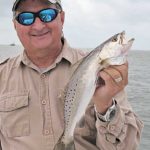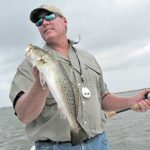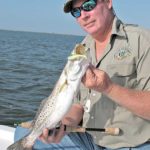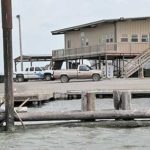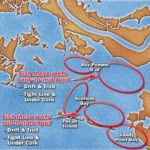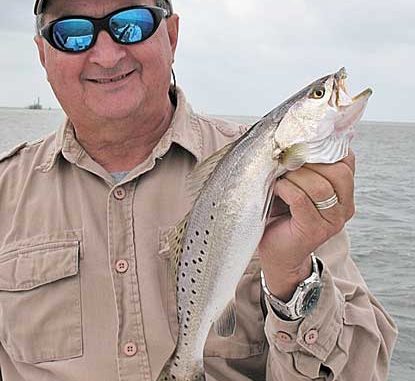
This port’s oyster reefs hold trout and reds in April.
March has the reputation of being “kite-flying weather.” It might not be the best month for fishing, but it’s perfect if you want to get that kite airborne. You won’t even have to run to get some air under the kite. Just hold it aloft, and the winds will do the rest.And if April dishes up more of what March put on the plate, we’re likely in for a blustery month.
But not everyone complains about the winds. If you know some areas that will produce nice fish under less-than-calm conditions, why complain? Especially when you can take full advantage of a month many anglers will sit out waiting for May to arrive.
The key is where you fish this month, and how. But I’ve come to realize that the where is more important than the how. Especially right now. By the time summer gets here, the where won’t be as essential because everybody knows where the fish will be then — outside.
But right now it’s different. The fish are scattered. They’re not really schooled up under shrimp or baitfish like they will be later on. Perhaps by mid-month, you’ll start to see some trout action under the birds as their favorite food supply makes its annual appearance, but until then, you’ll have to find fish yourself.
To help you do that, you need to remember two things: 1) oyster reefs, and 2) clean water.
These two tips originate with Capt. Ryan Lambert, who has operated Cajun Fishing Adventures (985-785-9833) for 28 years. Located downriver in Buras, Lambert believes he has the best of both worlds at his fingertips.
“We can launch in Buras right here at Joshua’s and fish the west side, or if the winds mess up the west side, we’ll launch at Lloyd’s Riverside and fish the east side,” he said.
Our plan was to fish the west side, mere minutes from the marina, over lumps and reefs that should be holding speckled trout and perhaps a redfish or two. We launched his 22-foot Skeeter at Joshua’s, and the 250 Yamaha four-stroke putted us just around the corner.
Lambert’s plan was to drift and troll in some shallow water and sight-cast for reds. I hoped we’d also get the chance to toss some topwater baits for big specks and reds. Unfortunately, neither of us got what we wanted because a heavy cloud cover squatted on top of us, totally obscuring the sun and making sight-casting impossible, and a devilish wind kicked up to 25 mph, and blew like that all morning.
We trolled and drifted awhile for reds, but without the sun to see by, all we could do was catch glimpses of redfish taking off whenever we got close enough to spook them. They were long gone by the time we could cast a bait in their direction. The redfish were there, but under those conditions, we just couldn’t spot them in time to get our baits near them.
To make matters worse, big algae blooms had moved into the area in huge clods, probably blown in by the wind, and casting between the big pods was becoming more and more difficult.
“When Plan A doesn’t pan out, switch to Plan B,” Lambert said as he reeled in and stuck his rod in the rod holder.
What was Plan B?
“Specks on the reefs,” he said.
The water we fished would have once been in the area designated Bay Pomme D’Or, but thanks to coastal erosion, several hurricanes and successive government administrations long on talk and short on actions, it’s more accurately called the Gulf of Mexico.
“Unfortunately, Bay Pomme D’Or is no more,” Lambert said. “As you can see, its all open water here now, and the Gulf is lapping at our doorstep.”
Two places to fish
Lambert moved us mere minutes away to an open area near some submerged reefs. The water was shallow, 2 to 3 feet, and the reefs, once a shell bank, were invisible under the surface.
“You really have to get to know your water,” Lambert said. “That is another key to having successful trips on marginal days. If you didn’t know this reef was here, you’d motor right past it, and you’d pass up a great spot for specks and reds.
“I encourage people to be observant, notice where structure is that will hold fish, and remember where they caught fish in a particular month and under what conditions. Learn your water, observe the depth sounder for hills and furrows, which could indicate reefs or structure, which might hold some fish.”
He dropped the trolling motor over the bow, and showed me where to cast.
“This was a good shell bank up until the last hurricanes. It’s submerged now, but it still holds trout,” he said.
And to accent his point, just a few minutes later, he had a good trout on the line. The wind was blowing so hard the boat drifted quickly away from the zone we wanted to fish, so Lambert cranked up and went back to the place we started.
“This is the game you have to play right now, drift and re-drift, and if you get a hit, stick the pole down and try to stay on some action,” he said.
This time, Lambert was better prepared, and on the next strike, he pushed the button on the remote he slung around his neck, and the Powerpole it controlled stuck us fast to the bottom.
“I’ve just got to get me one of those things,” I mumbled to myself, as I hooked my first trout of the day.
“Worth every penny,” he mumbled back.
“You want to remember that these fish are scattered, so you have to keep moving,” he said. “Don’t beat your brains out in an area that has no fish. Move until you find them.”
And move we did. But never very far.
We next drifted along an underwater ridge that was once a canal bank, and we put several nice specks in the box.
“The trout are hanging along the ledge of the old canal, so cast up where it’s shallow, and let your bait fall off the ledge. They’ll hit it on the way down,’ he instructed.
And they did.
From there, we headed to some nearby oyster reefs, clearly marked by the white poles of the leaseholder, staking out his territory.
“This is where most people should go this month, to areas with oyster reefs that are still near deeper water,” Lambert said. “It’s a no-brainer. Just head to the white poles marking the oyster reefs.
“Generally, the reefs closer inside will pay off in late March and early April, and by mid-April, the reefs farther out will produce better, those around Scofield Bay and Sandy Point Bay, closer to the big water.
“If March turns mild and the month ends with a streak of moderate weather, that move to the farther reefs could come earlier; it all depends on the weather.”
We drifted along the white poles and tossed our baits between them, reeling in slow enough to entice a strike, but not so slow that we’d hang up on the oyster bottom. It was the right technique because the trout nailed our baits. Lambert was still tightlining either a chartreuse or purple Cocahoe on a ¼-ounce jighead, the same colors he’d used all day. I’d been tightlining a white Salt Water Assassin curl-tail on a ¼-ounce jig, and getting a lot of attention from the trout, but at Lambert’s suggestion, I switched to an Old Bayside Paradise Popper cork rig, and that actually produced even better.
“The cork rig keeps the bait in the strike zone a little longer than tightlining plastics,” Lambert explained. “And we’re drifting so fast in this wind, that little extra time in the strike zone is paying off.”
The next set of poles we drifted, again just minutes away from the others, produced some redfish. We caught a few rat reds at first, but then the big boys came out to play. Lambert hooked a hefty fighter that we initially thought was a big black drum, which love to munch on the oystermen’s reefs. But this fish ran steady and far, more the trademark of a redfish than a drum.
After fighting it for several minutes, we caught the flash of a big bronze back, and we knew it was a red for sure.
“This is why I spool up with Power-Pro,” Lambert said. “I can horse these fish around, and the way this fish is rolling and twisting, he’d have broken off monofilament by now. Most of our customers would probably lose a fish this size if they were using mono.”
Lambert brought the big fish alongside the boat, and I netted and deposited it on the floor. We’d take a few photos, and release it to fight another day.
“By the way,” Lambert said. “This will be a great month for topwater action around the reefs and flats, wherever you find some shallow structure, signs of baitfish (especially mullet) and clean water. Every year at this time, we catch trout in the 7- and 8-pound class out here, and this is the month it happens.”
Unfortunately, the horrible winds were chasing us in and I never did get to toss that topwater bait for monster trout. But now that April is here, I plan to do some bouncing around Buras on my own until I find them.
Capt. Ryan Lambert can be reached at (985) 785-9833.
